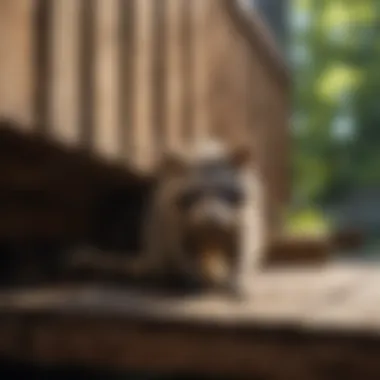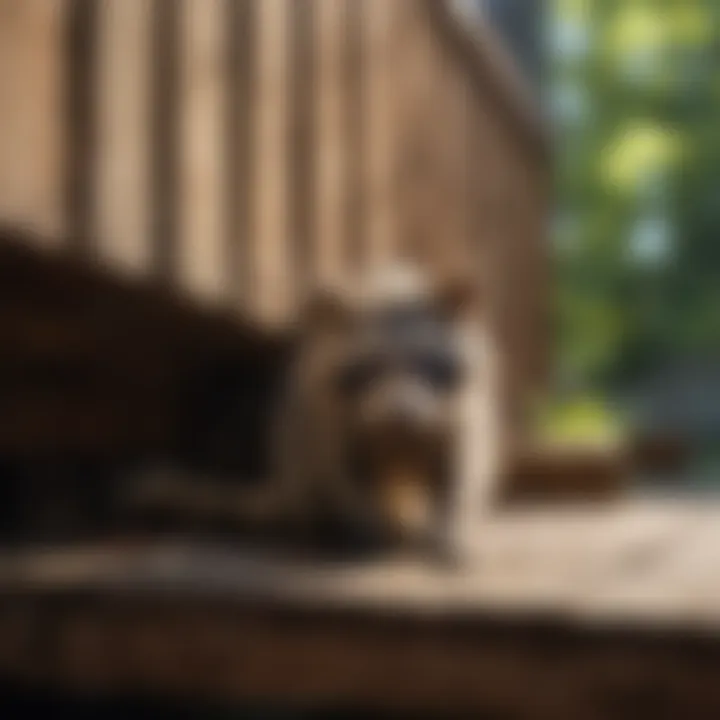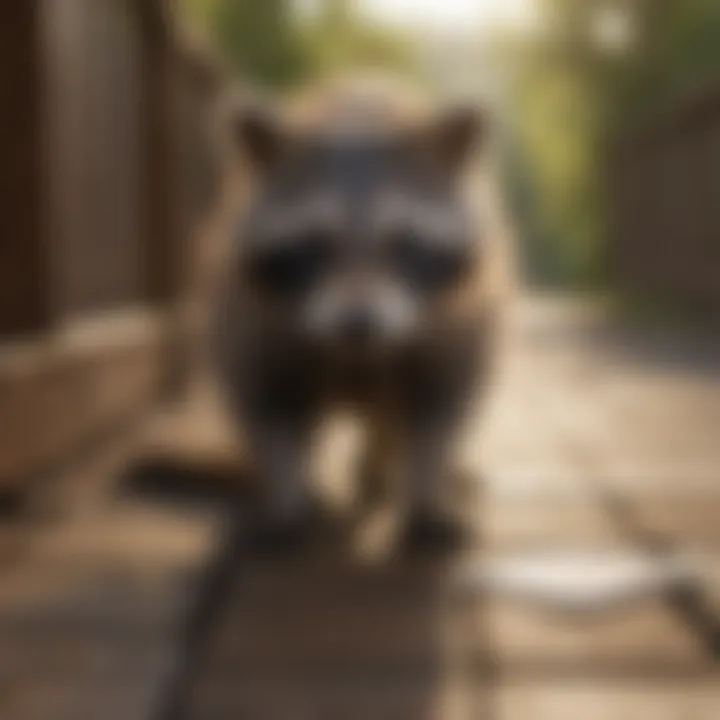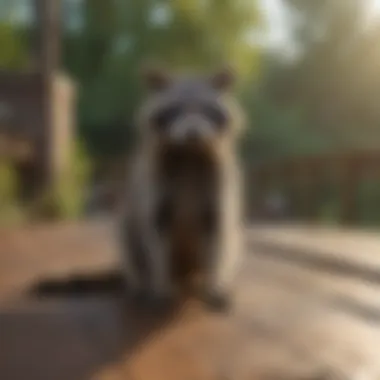Effective Strategies for Raccoon Removal Under Decks


Preventive Pest Control Strategies
When it comes to keeping raccoons and other pests at bay, the best approach is to prevent their access to your home and property. A stitch in time saves nine—applying some preventive measures can save you a lot of hassle down the line.
House Exterior Protection
Raccoons are clever little critters, and they know how to take advantage of the tiniest opening. Protecting your home’s exterior is the first line of defense in pest control.
- Tips for sealing cracks: Regular inspections are crucial. Look for cracks around windows, doors, and foundation walls. Use caulk or weatherstripping to fill any gaps that could serve as entry points.
- Clearing debris: Make it a habit to keep your yard free of clutter, like old wood piles or unused equipment. Raccoons find these spots cozy, increasing the likelihood they'll settle in.
- Preventing pests from entering: Install sturdy screens on vents and windows. Ensuring tightly closed doors and a well-maintained roof goes a long way.
Yard Maintenance
Proper yard care can deter more than just raccoons. A well-maintained yard is less likely to attract various pests.
- Essential yard care routines: Regularly mow your grass, prune overgrown bushes, and trim tree branches that hang too close to your house. This minimizes areas where critters can hide.
- Methods for keeping yard pest-free: Consider planting specific herbs or flowers that repel pests. Marigolds, for example, are a natural deterrent as they keep a wide range of insects away from your garden.
Indoor Cleanliness
An ounce of prevention is worth a pound of cure. Maintaining cleanliness indoors ensures raccoons aren’t looking to set up camp in your home.
- Expert cleaning tips and techniques: Regularly clean areas like pantry shelves, under appliances, and around trash bins. Raccoons love scavenging for leftovers!
- Maintaining a pest-resistant indoor environment: Seal up any food containers and store pet food in airtight bins. A little vigilance can go a long way.
Garbage Disposal
Keeping your garbage securely contained is crucial when it comes to discouraging raccoons.
- Efficient waste disposal methods: Always use trash cans with tight-fitting lids. This way, even the most persistent raccoon won’t be able to get in.
- Importance of proper garbage disposal: Ensure your trash is taken out regularly. It’s simple as that; less garbage means fewer temptations!
Other Pest Prevention Strategies
Thinking outside the box is often the key to keeping your home pest-free.
- Innovative ways to safeguard your home: Consider using motion-activated lights and noise devices. These surprises can scare unwelcome guests away.
"Prevention is the best medicine." 🚫🐾
By implementing these preventive strategies, you'll reduce the chances of raccoons and other unwelcome visitors making themselves at home under your deck. Every effort adds up, so don’t underestimate the power of small changes.
Understanding Raccoons and Their Behavior
Understanding raccoons and their behaviors is the first step in effectively removing them from underneath your deck. By gaining insights into their characteristics, feeding habits, and shelter preferences, homeowners can better equip themselves to deal with an infestation. Furthermore, this understanding helps in determining humane removal tactics, emphasizing the need for thoughtful management of wildlife interactions.
Characteristics of Raccoons
Raccoons are easily recognized by their distinctive facial markings resembling a mask and their ringed tails. These creatures typically weigh between 10 to 30 pounds and can grow up to 25 inches long, making them a visible presence in suburban areas. Raccoons are nocturnal, meaning they are mostly active at night when it comes to foraging. Their front paws are remarkably dexterous, allowing them to manipulate objects with surprising skill. It’s not uncommon to see them attempting to open trash cans or doors, showcasing their intelligence and adaptability, which often leads to unwanted visits under decks or porches.
Common Habits and Diet
Raccoons are omnivorous, consuming a diverse diet ranging from fruits and vegetables to insects and small animals. They aren’t picky eaters, which contributes to their adaptability in various environments. In residential neighborhoods, they might rummage through garbage, looking for leftovers or anything edible that piques their interest. This foraging behavior often leads them to investigate places where food might be easily accessible, including your deck. Due to their habit of scavenging, if they catch a whiff of an enticing meal, it can quickly lead them to take refuge beneath your home.
Why They Choose Decks as Shelter
Decks provide a cozy refuge for raccoons, offering protection from predators and harsh weather. The enclosed space creates a sense of safety for them, making it an ideal area to rest and raise their young. Decks are often elevated, giving them a perfect vantage point to observe their surroundings. If there are entry points created by loose boards or gaps, the problem is exacerbated, allowing them easy access. Moreover, the shelter provides them proximity to potential food sources, be it scraps left behind by humans or access to gardens. This combination of shelter and food leads to raccoons considering decks as long-term residences.
Understanding these behavioral traits is critical for homeowners looking to remove raccoons safely and humanely, ensuring both the safety of the wildlife and the integrity of the home.
Signs of Raccoon Presence
Recognizing signs of raccoon presence is vital for any homeowner dealing with potential wildlife intruders. Understanding these signs can mean the difference between early intervention and continuing nuisance. Raccoons are clever critters, and they often leave subtle clues that might go unnoticed. Identifying these signs helps you determine not only whether raccoons are present, but also how severe the problem might be.


Being vigilant and proactive allows for effective strategies to be put in place before the raccoons get too cozy beneath your deck.
Physical Evidence to Look For
Physical evidence is one of the most concrete ways to confirm that raccoons have made themselves at home. Look for:
- Tracks: Raccoon footprints are typically about 2-4 inches long and can be identified by their five toes. If you find prints in mud or soft soil, you may have a visitor.
- Scat: Raccoon droppings contain remnants of their diet, often including seeds, berries, or even pet food. Scat is usually tubular and can resemble that of cats but will be thicker with more irregular ends.
- Nesting Materials: Shredded paper, leaves, or insulation material can indicate they’re nesting in your deck. These are often dragged into their hiding spot, suggesting a longer-term stay.
- Scratches or Rub Marks: Signs of their movements can also be seen under your deck. Look for scratch marks on wood or rub marks where they've scraped their bodies.
It’s important to periodically check for these signs. If spotted, it’s high time to develop a plan of action.
Noises and Disturbances at Night
Raccoons are nocturnal, so disturbances or odd noises during the night can also signal their presence. Many homeowners have reported:
- Chirping or Chattering: Raccoons communicate in a range of sounds. Listening for soft chirps or more loud noises, particularly around dusk or dawn, serves as a strong indicator.
- Scratching Sounds: As they move, their claws can make noticeable scratching noises, especially when they’re trying to dig or nest.
- Bumping or Thumping: If you hear sudden thuds or bumps at night, it may stem from raccoons scurrying around, pushing things out of the way or playing.
Keep your ears open at night. Trust your instincts—if something feels amiss, it likely is.
Damage Assessment
Once you believe you have raccoons under your deck, assessing potential damage is crucial. Book a quick inspection to:
- Inspect Structures: Look for damaged wood, cut wires, or compromised plumbing—all possible consequences of raccoon activity. Their sharp claws can tear through various materials with ease.
- Check for Holes: Look for new holes or areas that seem enlarged. Raccoons will often create entrances that might compromise the integrity of your deck and even allow for other pests to join.
- Monitor Equipment: Ensure that your outdoor equipment, like grills or garden hoses, haven't been tampered with or damaged. Raccoons can be quite mischievous and may create setups for their comfort around these items.
"Damage that goes unnoticed can lead to bigger problems down the line. Better to be safe now than sorry later."
In summary, understanding the signs of raccoon presence not only enables you to respond quickly but also ensures you can take preventive measures right from the get-go. Keep an eye and an ear out, and be ready to take action when you discover these signs.
Legal Considerations Regarding Raccoon Removal
Addressing the topic of the legal aspects of raccoon removal is crucial for homeowners facing this wildlife nuisance. Ignoring regulations can lead not only to potential legal repercussions but also to encounters that might be harmful for both the raccoons and residents. Thus, educating oneself on the local wildlife laws and understanding the ethics surrounding wildlife management can prepare a homeowner for a more sensible approach in handling raccoon situations.
Local Wildlife Laws and Regulations
Before embarking on any raccoon removal efforts, it's vital to familiarize yourself with your area's wildlife laws. In many locations, raccoons are protected under specific regulations which vary widely from state to state. Here’s what you should consider:
- Permits Required: Certain states may mandate a permit to trap and relocate wildlife. Failing to obtain the necessary permissions can result in fines that can punch a hole in your wallet.
- Prohibited Actions: Some jurisdictions prohibit certain removal methods, such as poisoning or lethal traps, which can cause undue suffering and potentially violate animal welfare laws.
- Consulting Local Agencies: Contact your local wildlife agency for detailed guidance on what actions are acceptable. They can also provide insight about potential guidelines, helping you avoid the legal tightrope.
It’s also wise to keep in mind that some towns provide resources for humane relocation, making sure that laws are upheld without sacrificing safety.
Ethical Considerations in Wildlife Management
Ethical considerations in wildlife management shouldn't take a back seat when it comes to dealing with raccoons. While homeowners are naturally concerned about their properties, it's essential to balance personal interests with the welfare of the animals. Here’s how you can reflect an ethical mindset:
- Adopting Humane Practices: Always prioritize humane options, such as live trapping, when removing raccoons from your property. This approach prevents unnecessary suffering and should be guided by your local wildlife regulations, ensuring that the animals are treated with respect.
- Relocation: If relocating is necessary, do so with the guidance of experts. Ensure the new location can support the raccoons without leading them into more human populated areas where they might face danger.
- Ecological Impact: Consider the broader ecological implications of removing raccoons. They play a role in their habitats, and having an eco-friendly mindset helps maintain balance in local wildlife ecosystems.
Ethical wildlife management isn't just about removing a nuisance from under your deck. It's about finding solutions that respect animal welfare and foster a harmonious relationship with nature.
Assessing the Situation Under Your Deck
Before embarking on any raccoon removal efforts, it is essential to first assess the situation under your deck. Understanding the environment that these creatures have chosen can make all the difference in how you approach their removal. This assessment involves not just a casual glance but a thorough investigation to identify signs of habitation and understand the extent of the problem. The benefits of such an assessment can’t be overstated: it helps to prioritize safety, tailor your strategies effectively, and enhances your chances of success.
Inspection Techniques
Inspection techniques serve as your first line of defense in dealing with raccoons. Start by wearing protective gloves and possibly a mask, especially if you suspect droppings or nesting materials are present. Here are some methods to consider:
- Visual Inspection: Look for any visible signs of raccoon activity. This could include tracks, scratch marks, or even the presence of raccoon feces. Use a flashlight to look into dark corners where these signs might be hidden.
- Surveillance Cameras: Employ motion-activated cameras around the area. This tactic can not only confirm raccoon presence but also provide insight into their behavior and timing.
- Listening Techniques: Quietly standing near the deck at dusk or dawn can reveal sounds indicative of raccoon activity. Listen for rustling, growling, or any vocalizations.
The combination of these techniques will provide a clearer picture, allowing you to strategize effectively for removal.
Identifying Entry Points


Spotting entry points is crucial in your mission to remove raccoons. These clever creatures are adept at finding their way into small spaces, so here are some key areas to investigate:
- Gaps and Cracks: Examine the foundation and the area around your deck. Raccoons can squeeze through surprisingly small openings, so any gaps larger than a handful should be inspected.
- Overhanging Debris: Vegetation that grows too close or even protrudes under the deck can serve as a ladder for raccoons. Identify low branches or thick bushes that need trimming.
- Damage Indicators: Peeling or broken wood, particularly near supports of the deck, might hint at areas used by raccoons. Damaged boards may be more accessible than you think.
- Ventilation Holes: Check any vents or openings around your property. Raccoons sometimes use these holes as entryways when seeking shelter.
By methodically identifying these potential entry points, you not only ascertain how raccoons are getting in but also prepare for effective sealing post-removal.
Remember: A thorough assessment under your deck is as much about understanding raccoon behavior as it is about finding physical evidence. Take your time and be diligent.
Humane Removal Methods
Humane removal methods play a crucial role in addressing raccoon infestations beneath your deck. These strategies prioritize the welfare of the animals while effectively resolving the issues they cause. Following humane practices not only protects local wildlife but also contributes to a responsible balance between humans and nature. By employing methods that minimize stress for the raccoons, you help maintain ecological integrity.
Live Trapping Techniques
Live trapping is widely considered one of the most effective humane methods for removing raccoons from under your deck. This technique allows for the capture of these creatures without causing them harm. Here are some essential considerations regarding live trapping:
- Choosing the Right Trap: Select a trap that is specifically designed for raccoons. Size matters. A trap that’s too small may injure the raccoon, while an overly large trap won’t be effective.
- Baiting the Trap: Use attractive bait to lure raccoons into the trap. A mix of peanut butter and marshmallows is often recommended due to its strong scent and palatability.
- Placement of the Trap: Position the trap near the entry points of the deck where raccoons are known to visit. Make sure it’s stable on the ground to avoid tipping over and scaring them away.
- Monitoring the Trap: Check the trap frequently, ideally every few hours. Animals left in traps for extended periods can experience unnecessary stress, which isn't the goal of humane removal.
- Releasing the Raccoon: Always follow local laws regarding release. Ideally, relocate the animal at least several miles away from your home to reduce the likelihood of return. Ideally, this location should offer a suitable habitat away from human dwellings.
Using Natural Deterrents
In addition to live trapping, leveraging natural deterrents can greatly assist in pest management without causing harm to the raccoons. These deterrents help make your deck less appealing to them, encouraging them to seek shelter elsewhere. Here are some effective options:
- Predatory Sounds: The use of recordings that mimic the sounds of natural predators, like coyotes, can scare raccoons away from your deck area.
- Odorous Repellents: Strong scents are sometimes enough to dissuade raccoons. For instance, applying a mixture of vinegar or cayenne pepper around the entrance can create an unpleasant environment for them.
- Motion-Activated Sprinklers: Such devices can provide a sudden water spray that startles raccoons, encouraging them to vacate the area without causing any harm.
- Natural Barriers: When feasible, integrate physical barriers like thorny bushes or prickly plants around the perimeter of your deck. These not only make access difficult but also serve as a natural deterrent.
By focusing on humane strategies for removing raccoons, homeowners create a safer environment for both the raccoons and themselves. Not only do these methods help in resolving immediate issues, but they also foster a respectful atmosphere where wildlife can coexist harmoniously with human dwellings. Remember, taking these humane approaches enriches the community by protecting the delicate balance of nature.
Professional Assistance for Raccoon Removal
Turning to professional help for raccoon removal isn’t just a good idea; it can be the wisest decision a homeowner can make in dealing with these clever creatures. While some folks might try their hand at DIY methods, enlisting the expertise of a wildlife control expert can truly save time, avoid stress, and ultimately ensure a more effective outcome. Raccoons can be unpredictable, and they carry risks of disease—something that should never be ignored.
One significant advantage of hiring a professional is their understanding of local wildlife regulations. Each region may have its own laws surrounding the removal and treatment of raccoons, and a professional will be well-versed in these guidelines. In many cases, these experts have the necessary permits to properly handle and relocate wildlife without legal consequences.
Furthermore, wildlife control specialists possess the tools and techniques needed to safely and humanely remove raccoons from under your deck. These methods often outstrip the typical homeowner’s access to equipment and knowledge. This can be a game changer, especially when it comes to preventing harm to both the animal and your property.
"Trying to remove a raccoon without proper guidance can lead to damaging your home—and might even result in injury. It’s better to leave it to the pros."
In addition, professionals can provide invaluable follow-up advice on how to ensure these critters don’t come back. An expert’s viewpoint often includes insights into general wildlife management practices that can help homeowners maintain peace in their outdoor spaces for years to come.
When to Call Wildlife Control Experts
Knowing when to call in the big guns can make all the difference. If you’ve tried various deterrents without success, or if you notice persistent presence of raccoons, it’s time to make that call. Here are a few indicators that suggest you should stop the DIY approach and contact a professional:
- Frequent visits: Are you observing the raccoons regularly? This signals they might have made a home for themselves.
- Signs of damage: If they’re chewing through your deck or tearing up landscaping, the situation could get worse without professional intervention.
- Health concerns: Raccoons can carry parasites and diseases, risking your family’s health. If you notice a raccoon exhibiting erratic behavior or illness, it's crucial to contact a professional immediately.
Selecting a Reputable Service Provider
Choosing the right wildlife control service is essential for successful removal and management of raccoon issues. Start by looking for providers with solid local reputations. Check online reviews on sites like Facebook or Reddit, as they can offer genuine insight into a service’s reliability.
When you speak to potential providers, ask about their methodologies for removal. Make sure they practice humane techniques, such as live trapping, rather than lethal methods. This aligns with a growing trend toward ethical wildlife management.
It’s also wise to inquire about their experience and qualifications. Professionals should have licenses and certifications relevant to wildlife management in your area.
- Does the provider offer a follow-up plan or advice on preventing future raccoon problems?
- Are they insured? Liability coverage is crucial to handle any unforeseen incidents during the removal process.
- What guarantees do they provide? Some companies will offer warranties on their work, which can save you in the long run.
Taking the time to do proper research can save you headaches down the road and bring you peace of mind as you tackle the raccoon situation beneath your deck.
Post-Removal Considerations
Once you’ve dealt with the immediate challenge of raccoons under your deck, pausing for a moment to reflect on what comes next is valuable. Post-removal considerations are crucial not just for ensuring that the same issue doesn’t pop up again, but also for maintaining your home’s health and safety. After all the effort involved in removing these pesky intruders, safeguarding your space from possible future visitors should be top of mind.
Cleaning and Disinfecting the Area


Cleaning and disinfecting the area where the raccoons were residing is like taking a deep breath after holding it for too long. You’ve taken care of the problem, but remnants of their stay could still linger in ways you might not consider. First off, raccoons can leave behind droppings and urine that pose health risks, particularly with diseases like raccoon roundworm and leptospirosis. Therefore, rolling up your sleeves for a thorough clean-up should be your first task.
When approaching this, take care to use gloves and a mask to protect yourself from direct contact with any contaminants. Here’s a quick step-by-step:
- Remove Debris: Pull up any materials from under the deck that could harbor waste or nesting materials. Discard these responsibly, preferably in sealed bags.
- Disinfecting the Area: Use a solution of bleach and water, or a commercially available disinfectant, to clean the surfaces thoroughly. Focus on areas that showed signs of raccoon activity.
- Drying: Allow the area to air-dry completely, as damp spots may attract other wildlife.
- Assessing for Damage: While cleaning, take a close look for any structural damage caused by the raccoons. Fix any issues to prevent water leaks or further deterioration of your deck.
Taking these steps doesn't just ensure cleanliness—it contributes to a healthier home environment for you and your family.
Monitoring the Area for Future Activity
After cleaning, setup a strategy for monitoring your deck for any signs of returning raccoons or other critters. Keeping your eyes peeled can save you a lot of stress down the line. Here are some effective ways to monitor post-removal:
- Visual Inspections: Regularly inspect underneath the deck for any signs of new digging or droppings. A quick glance every couple of weeks can be sufficient to catch any early signs of trouble.
- Camera Traps: If you're feeling a bit techy, consider installing wildlife cameras in the area. They can offer insights into whether raccoons or other animals are still lurking around without your constant vigilance.
- Check for New Nesting Material: Raccoons tend to forage. Keeping an eye on whether new materials appear under your deck can be telling. If you find fresh twigs or leaves, it might be time to intervene.
- Listening for Sounds: Pay attention to the noises at night. Raccoons are nocturnal, and sounds of scuttling may indicate their return.
Ultimately, staying proactive after dealing with a raccoon situation isn’t just a good idea—it’s a necessity for ensuring your home remains a safe and comfortable haven. By following through with cleaning and closely monitoring the area, you can enjoy your outdoor space without the worry of unexpected visitors.
Strategies to Prevent Raccoons from Returning
Preventing raccoons from re-establishing their homes under your deck is as pivotal as the initial removal process. Once you've successfully evicted these furry intruders, the last thing you want is for them to come back and make themselves at home again. Several key strategies can help ensure your outdoor space stays raccoon-free, enhancing your peace of mind and preserving your home's integrity. Let's dive into the specifics of keeping these persistent animals at bay.
Sealing Off Entry Points
A crucial step to deter raccoons is ensuring they cannot access shelter areas like under your deck. Sealing off entry points is not just about blocking pathways; it requires thorough examination of your property.
- Identify Gaps and Holes: Check for any vulnerabilities in your deck. Raccoons can squeeze through surprisingly small spaces, so pay attention to openings around pipes, utility lines, and corners where the deck meets the ground.
- Use the Right Materials: For sealing gaps, materials like heavy-duty wire mesh or metal flashing work best. Wood or lighter materials might be easily chewed through again.
- Secure Garbage and Compost: Close attention should be given to whether your trash bins and compost piles are secure as well. These are prime attractants and easy entry points that you don’t want to overlook.
Once you have sealed off these access points, take note of any signs of persistent raccoon behavior. Regular checks will ensure that your handiwork holds up against their cleverness.
Keeping the Area Clean and Tidy
Raccoons are drawn to food sources, so maintaining a neat outdoor environment is essential. The philosophy here is basic: keep it clean, and they won't stay!
- Remove Food Sources: Don’t leave pet food outdoors overnight, and be diligent about cleaning up after barbecues. Even the smallest food scraps can entice raccoons to return.
- Yard Maintenance: Regularly mowing your lawn, trimming bushes, and cleaning up fallen fruit from trees can reduce raccoon attraction. A tidy yard sends the message that there's no banquet waiting for them.
- Use Trash Cans Wisely: Use raccoon-proof trash bins with secure lids to eliminate an easy meal option. Securing your waste can do wonders in making your property less appealing.
By adopting a proactive cleaning routine, you'll not only create a less inviting environment for raccoons but you’ll also enhance the overall aesthetic of your outdoor space.
Using Deterrents Effectively
While sealing and cleaning may reduce access and appeal, employing deterrents can further reinforce your defenses against raccoons returning.
- Natural Smell Deterrents: Strong odors like garlic, hot pepper, and vinegar can deter raccoons. Spraying these substances around the perimeter of your deck and entry points can create an unpleasant environment for them.
- Motion Sensors: Installing motion-activated lights or sprinklers can startle raccoons and discourage them from approaching. The unexpected burst of light or spray can be enough to make them think twice.
- Sound Deterrents: Ultrasonic pest repellents emit high-frequency sounds that are uncomfortable for raccoons but often inaudible to humans. Consider this option if you’re looking for a humane but effective deterrent.
Using these deterrent methods in combination with sealing and keeping the area clean can create a multi-layered approach that effectively keeps raccoons at bay.
Remember: Prevention is always better than having to deal with a raccoon problem again. By investing time in these strategies, you reduce the likelihood of encountering these clever creatures once more and make your home a sanctuary.
Concluding Thoughts on Raccoon Management
Managing raccoons effectively requires a comprehensive understanding of their behavior and a balanced approach to coexisting with wildlife. Raccoons have adapted remarkably well to urban settings. This adaptability makes it essential for homeowners to consider the broader implications of raccoon removal. It’s not just about solving the immediate problem of raccoons under your deck but ensuring sustainable coexistence that respects both human and animal needs.
Importance of Human-Wildlife Balance
Maintaining a balance between human interests and wildlife preservation is crucial. Many people may view raccoons merely as pests. However, they play a role in our ecosystem, aiding in seed dispersal and pest control. By taking a more conscientious approach, homeowners can mitigate raccoon issues while also helping to conserve their populations.
Strategies that promote this balance include thoughtful landscaping that minimizes food sources and shelter options for raccoons, rather than resorting to punitive measures. Education about raccoon habits fosters understanding. For instance, knowing that dusk is when they are most active urges homeowners to secure trash bins or bring pet food indoors at night. This proactive approach helps residents remain in control of their environment without undermining the welfare of the raccoon populations.
Long-Term Solutions for Homeowners
For homeowners, addressing raccoon issues requires consistent effort beyond immediate removal tactics. After removing any raccoons, attention should turn to long-term preventive measures. Begin with sealing potential entry points such as gaps in fencing, crawl spaces, and under-deck areas using durable materials. Protecting access to these places is integral.
Regular maintenance of yards can also deter raccoons. Keeping the area tidy and free of debris eliminates hiding spots, while removing food sources such as fallen fruits and unsecured pet food further discourages their presence.
Finally, consider natural deterrents like motion-activated sprinklers or lights to safely relocate raccoons. This method is humane and keeps homeowners at a safe distance from potential interactions.
"A well-maintained yard speaks louder than deterrents."
In summary, effective raccoon management needn't be adversarial. With a focus on understanding and sustainable practices, homeowners can enjoy their outdoor spaces while contributing to a balanced urban ecosystem.



